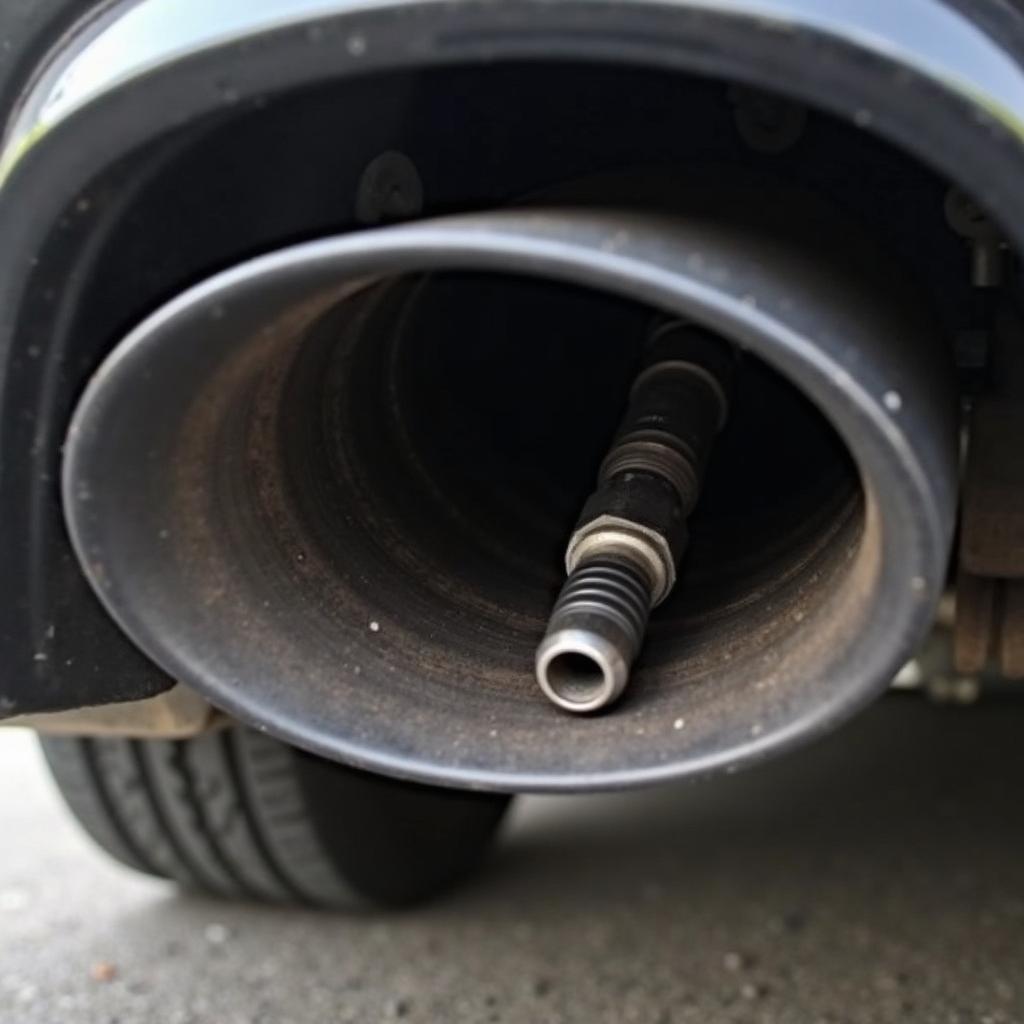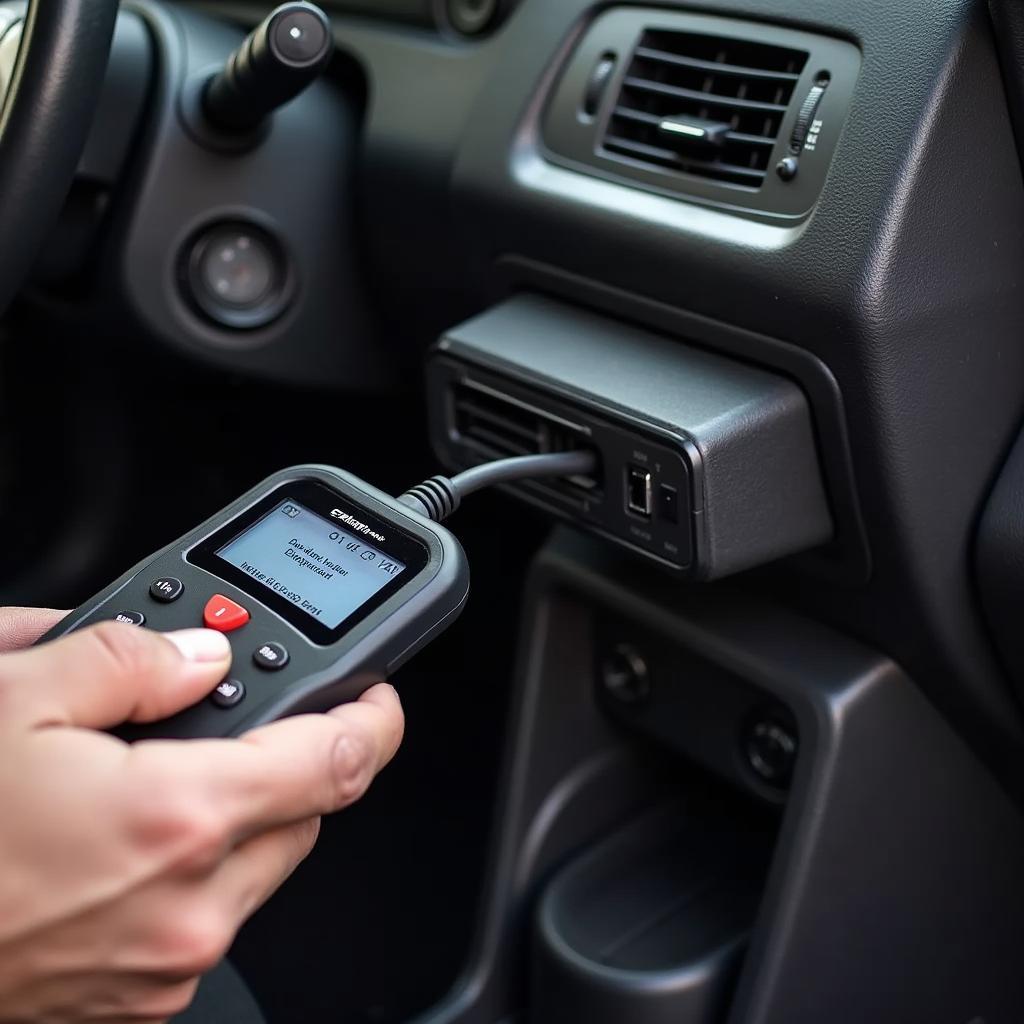Is your “Check Engine” light on and your OBD2 scanner showing an O2 error? Don’t panic! In this article, we’ll explain what an O2 error means, its possible causes, and how you can diagnose and potentially fix the issue yourself.
 Automotive O2 sensor installed in an exhaust pipe
Automotive O2 sensor installed in an exhaust pipe
What is an O2 Error?
The O2 sensor, also known as a lambda sensor, is a crucial part of your car’s engine management system. It measures the oxygen level in the exhaust gases and sends this information to the engine control unit (ECU). Based on this data, the ECU adjusts the fuel-air mixture for optimal combustion and reduced emissions.
An O2 error means the sensor is sending incorrect or implausible readings to the ECU. This can happen for various reasons, from simple sensor contamination to a fault in the wiring harness.
Common Causes for O2 Errors
- Contaminated O2 sensor: Over time, the sensor can become fouled by deposits in the exhaust gas.
- Defective O2 sensor: Like any other component, the O2 sensor can age and fail.
- Leaks in the exhaust system: Cracks or holes in the exhaust manifold, catalytic converter, or exhaust pipes can lead to false readings.
- Defective catalytic converter: A defective catalytic converter can also trigger an O2 error.
- Problems with the fuel supply: A faulty fuel injector or a defective fuel filter can lead to an incorrect fuel-air mixture.
Diagnosing an O2 Error
Before starting any repair, it’s crucial to pinpoint the exact cause of the O2 error. An OBD2 scanner is an indispensable tool for this. It allows you to read the trouble code, providing initial clues about the problem.
 Hand holding an OBD2 scanner plugged into a car's diagnostic port
Hand holding an OBD2 scanner plugged into a car's diagnostic port
In addition to reading the trouble code, you should check the following:
- Visual inspection of the O2 sensor: Examine the sensor for visible damage or heavy contamination.
- Inspection of the exhaust system: Look for cracks, holes, or loose connections in the exhaust system.
- Inspection of cables and connectors: Ensure all cables and connectors to the O2 sensor are intact and correctly connected.
Solutions for O2 Errors
Fixing an O2 error depends on the specific cause. In some instances, simply cleaning the sensor or replacing a faulty wire is sufficient. In other cases, it might be necessary to replace the O2 sensor, catalytic converter, or other related components.
Here are some potential solutions:
- Cleaning the O2 sensor: Cleaning the sensor with a special cleaning agent can remove deposits and restore its functionality.
- Replacing the O2 sensor: A defective sensor usually needs to be replaced. Make sure to use the correct sensor for your vehicle model.
- Repairing the exhaust system: Cracks or holes in the exhaust system must be professionally welded or sealed.
- Replacing the catalytic converter: A defective catalytic converter usually needs to be replaced.
What Happens If You Ignore an O2 Error?
An O2 error should not be ignored. A continuously faulty signal from the O2 sensor can lead to the following issues:
- Increased fuel consumption: The control unit can no longer optimally regulate the fuel-air mixture, leading to increased consumption.
- Loss of performance: An incorrect fuel-air mixture can lead to a loss of engine power.
- Damage to the catalytic converter: A persistently faulty mixture can damage the catalytic converter and result in high repair costs.
- Problems passing the emissions test: Your vehicle may not pass the emissions test if an O2 error is present.
O2 Errors: Prevention is Better Than Repair
You can prevent O2 errors from occurring with some simple measures:
- Regular maintenance: Have your vehicle regularly serviced at a workshop and the O2 sensor inspected.
- Use high-quality fuel: Cheaper fuel can contain more residues that can contaminate the O2 sensor.
- Gentle warm-up of the engine: Avoid hard acceleration when the engine is cold; let it warm up gradually.
Conclusion
An O2 error might seem harmless initially, but it can have significant consequences. Don’t ignore the issue; either seek assistance from a workshop or fix the problem yourself if you possess the necessary knowledge and tools. This will help maintain your vehicle’s performance and prevent costly subsequent damage.
Interested in other topics related to car repair and maintenance? Visit our website carautorepair.site and explore our wide selection of diagnostic tools, repair guides, and helpful tips for DIY assistance.
Frequently Asked Questions about O2 Errors
- Can I keep driving with an O2 sensor error? It’s not recommended to continue driving with an O2 error. The consequences can range from increased fuel consumption to catalytic converter damage.
- How much does it cost to fix an O2 sensor error? The cost of the repair depends on the specific cause of the error.
- Where is the O2 sensor located? The O2 sensor is located in the exhaust system, usually before or after the catalytic converter.
- Can I replace the O2 sensor myself? If you have some mechanical skills, you can likely replace the O2 sensor yourself.
- How can I tell if an O2 sensor is bad? Besides the illuminated Check Engine light, signs can include a rough engine idle, increased fuel consumption, or difficulty starting the engine.
Do you have further questions about “O2 Errors” or need help with your car repair? Contact our experts! We are happy to support you with advice and assistance.
